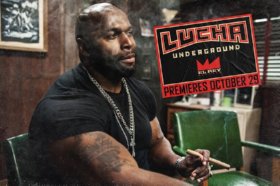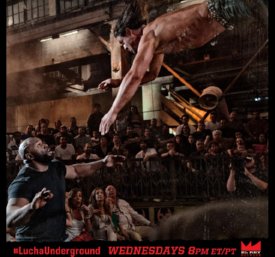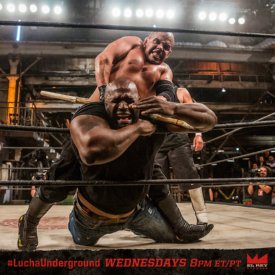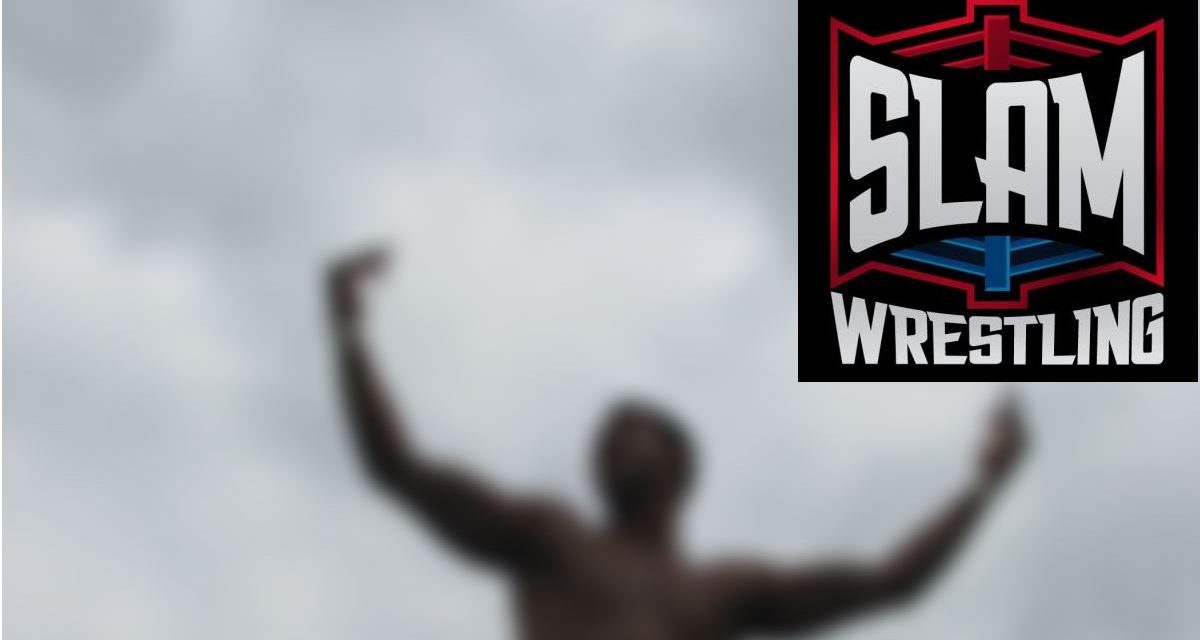Regardless of whether it’s as Ezekiel Jackson, Ricky Atlas or simply, Big Ryck, Rycklon Stephens is the kind of athlete that can walk into a crowded room and immediately become the centre of attention. This is probably one of the main reasons that he’s worked for nearly every major wrestling promotion in the United States.
“A choice that I made was to be a bruiser from the beginning. First and foremost, I’m an athlete. I was kind of told when I started, to be a big guy, which was kind of hard for me, because I felt that I could match anybody,” Stephens said. “So I’m going to be the big, bad guy that likes to hurt people. I think the fans are drawn to things like that.”
Stephens was born in Guyana, and although he didn’t have a lot of the same advantages that some of the other kids his age had, he would always find a way to watch wrestling; he made time for it.
“I was always a fan. Growing up, I never had a TV in my house, so I saw my first match through a neighbour’s window, and I was hooked,” Stephens said. “I would get my chores done early on a Friday, so I was free on a Saturday or Sunday to go watch wrestling.”
As much as Stephens wanted to follow his dream of being a professional wrestler when he moved to the States, he was also thinking realistically, so he came up with a few backup plans, just in case.
“I was ready to go into pro wrestling right after high school, but when I was faced with the decision to either follow my passion or go to school, I chose to go to school, because I wanted something that I could fall back on,” Stephens said. “So I went and got an education and got a degree, because I was the only one in my family who could go to college at the time.”
Stephens studied at the University at Buffalo and obtained a degree in Early Childhood Education, with minors in sociology and physiology. However, the thought of being a professional wrestler was still on his mind, and even though he was in school, he was focused on improving his physique, so when the time came for him to transition into pro wrestling, he’d be ready. During his college years, Stephens trained and competed in bodybuilding, powerlifting, and he also played football.
After college, the time came for Stephens to focus on his career. So he put his books aside, and decided to follow his dream of being a professional wrestler.

Most New Yorkers are well aware that Buffalo and Brooklyn are not exactly next door neighbours. But Stephens’ mind had already been made up, and the 6-hour driving distance was of no concern to him.
“I went to the dog house in Brooklyn, New York, where one of my trainers was Homicide, who is famous for his work in TNA, and he’s very popular in the indies,” Stephens said. “They were big on Japanese strong style, and I learned that wrestling was not fake in any sense; you learned how to work solid. So I started in July of 2000, and I made the choice to follow wrestling, instead of going to law school, because I also got into law school.”
It was at this venue where Stephens first met one of his close, long-time friends; a man by the name of Matt Striker. Actually, Striker’s career has almost run parallel to Stephens’. They both studied education in New York, they both worked for the WWE, and now both work for Lucha Underground.
“Ryck, who I believe was competing as Ricky Atlas at the time, actually reminded me that we met in a place called the Dog House in Brooklyn, New York. It was this dingy training centre, underneath the L train, and it wasn’t a place that a person like me would ordinarily find myself,” Striker said with a chuckle. “But he and I became friends instantly. We lost touch, and then our paths crossed again in the WWE world. Ryck is the kind of guy that if you saw him in the street and you didn’t know any better, you’d be afraid. But if you talk to Ryck for about 30 seconds, you’d find out that he’s just such a sweet man. My first impression of him was very Mike Tyson like; his personality does not suit his appearance at all.”
Stephens made his pro debut in 2001, mainly working in the New York area. But he has moved around quite a bit in his lifetime, and most of those decisions had to do with advancing his career. Once he was done training in Brooklyn, he got himself ready for another big move. His next destination: Los Angeles.
“I moved to L.A. in 2005, and I got in contact with UPW. A lot of guys at that time went to UPW at some point, whether it be Cena, Lisa Marie (Victoria), etc. I would perform in front of a lot of people from the WWE, so I committed to getting a job there from the 2006 summer, until I eventually got signed in January or February, 2007,” Stephens said. “When I got signed, I was in Deep South for like a month, which was in Georgia. And then they shut down there, and we were told that we were going to be moved to Tampa (Florida). So I got to Tampa, where I was trained by Steve Keirn and Dr. Tom Prichard. They told me I had potential.”
Even though he had been signed to a developmental contract at this point, Stephens still wasn’t on the road yet. He was still kind of on the outside, looking in; but at least he had a foot in the door, which is all he really needed.
“It (FCW) allowed me to learn what the WWE was all about. At the end of every month, somebody would come down and speak to us, whether it was Tony Atlas, or Superstar Billy Graham or somebody like Bret Hart, or some of the guys that lived in Tampa would be there, like Chris Jericho,” Stephens said. “Some of these guys would come down and you can pick their brains about what would happen when you come on the road. Our side stories are not what happened backstage; backstage is a whole different world. You’ve got to learn how to conduct yourself; you got to learn how to show respect. And we learned that in Tampa; learning how to respect the business first, before you got a chance to go on the road.”
Stephens got his big break in the summer of 2008; it was then, that he finally got called up to the main roster. Stephens has not only gone through many names in his career, but he’s also gone through many different roles. But his most familiar one is that of a bodyguard, or an advisor, as he would say.
A man of his size is hard not to notice. He definitely caught the attention of The Brian Kendrick, and later William Regal. In the early stages of his WWE career, he served as a corner man for both, but eventually, Stephens was moved into the spotlight, and Regal became his corner man.
“For Kendrick, I have a lot of respect for that dude. He chose me; he actually flew to Tampa with his fiancée at the time, to come and see me. I learned a lot from that guy. I learned a lot of efficiency from him, and just how to do a lot of dirty, grimy, evil stuff to make fans hate you,” Stephens said. “Then I moved in with Regal and Kozlov, and we teamed up. I’ve always admired Regal’s style. It’s easy to go out there and have a fight, but I learned how to fight, without hurting people. Once you get it right, it’s just such a simple thing.”
In its latter stages, Stephens became a huge part of the WWE’s ECW brand. In fact, he was the last recognized ECW Champion, winning that title on the final episode of ECW. Even though it was short-lived, it was still a huge moment for him, as it led to bigger and better things, such as winning the Intercontinental title about a year later.
“Whether it was at the last second or for four years, it was such a blessing to say that I held the ECW title,” Stephens said. “I’m just so happy that the company saw something in me, to put a title on me.”
Striker, who was calling the matches for ECW at the time, couldn’t have been happier to see his friend in the spotlight. He always enjoyed calling Stephens’ matches.
“While a lot of guys will go in the ring and try to impress either their peers or people on the Internet, Big Ryck always stayed true to himself, and never tried to be anything that he wasn’t,” Striker said. “So my first thought was that if this guy keeps his head on straight, he’s going to be successful. He leads by example. He’s a humble man; he’s a kind man.”
Quite possibly the biggest angle in 2010 was the formation of the Nexus. By the end of that year, the Nexus was split in half. Former Nexus leader Wade Barrett took his loyal followers, Justin Gabriel and Heath Slater, with him from Raw to Smackdown, and formed a new group called The Corre. The only thing missing was a fourth member. It was quite obvious that the WWE saw big things for Stephens at the time, since they felt confident enough to put him in this group. Stephens was put to the test here; he was truly swimming with sharks, but he survived the feeding frenzy, and actually got one of the biggest pushes after the break-up, as he won the Intercontinental title and got a fresh run as a babyface, all within a couple of months.

“The Corre had unfortunately run its course, but had it gone a little longer, we could have done phenomenal things,” Stephens said. “Working in a group, everybody gets their chance to shine. Heath and Justin were the tag champs, Wade was the IC champ and I was the muscle at the time. When the time came, I became the IC champ, and we moved on. But for the time being, we had three champions in the group at one time, and you can’t take anything away from that, when it comes to being a professional wrestler; you’re in a group of champions.”
After losing the Intercontinental title in 2011, Stephens wasn’t used nearly as much on television. He suffered an injury to his upper body about a year later, which put him on the sidelines for about another year, and then he eventually parted ways with the WWE in January 2014. But on the bright side, when that door closed, several windows opened, as Stephens’ phone was almost ringing non-stop.
Stephens had a brief run in TNA this past summer, and has now found a new home in Lucha Underground.
“I got a phone call, and they (TNA) told me that they wanted to bring me in to do something; I wasn’t sure what, but I knew a lot of the guys backstage, so I got along well with everybody. It was for a three-week deal with the possibility of coming back. I wasn’t doing anything at the time, so I took it, and I enjoyed my couple of days there; I had a blast,” Stephens said.

In Lucha Underground, Stephens was once a proud member of the Crenshaw Crew, along with Cisco and Cortez Castro, but was kicked out of the group on a recent episode. And now as a solo performer, Stephens’ biggest challenge lays ahead of him.
The majority of talents in Lucha Underground are light heavyweights, so Stephens already sticks out like a sore thumb, being the biggest man in the promotion at 6’4″ and 295 pounds. However, the term luchador translates to fighter, which is one of the most common terms used to describe a man of Stephens’ size.
“I think fans will accept true fighters for what they can bring, so as far as accepting Ryck as a good guy or a bad guy, I think the fans will accept Ryck as a legitimate fighter, and that’s all anyone in the Lucha Underground locker room is asking for,” Striker said. “There are so many differences between Lucha Underground and other promotions that the lines are sort of blurred. Root for whoever you want to root for; don’t root for who we tell you to root for. And that’s the beauty of Lucha Underground, in my opinion. I think Ryck is going to earn the respect of the people, just based on his fighting.”
Stephens is only 36 years old, so he’s still got a few good years ahead of him. He certainly plans to make the most of those years and continue to make an impact in the world of professional wrestling and maybe in the world in general.
RELATED LINKS

